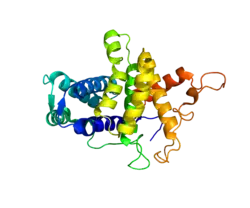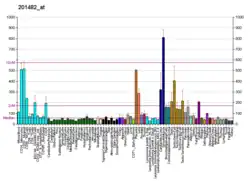QSOX1
Sulfhydryl oxidase 1 is an enzyme that in humans is encoded by the QSOX1 gene.[5][6][7]
| QSOX1 | |||||||||||||||||||||||||||||||||||||||||||||||||||
|---|---|---|---|---|---|---|---|---|---|---|---|---|---|---|---|---|---|---|---|---|---|---|---|---|---|---|---|---|---|---|---|---|---|---|---|---|---|---|---|---|---|---|---|---|---|---|---|---|---|---|---|
 | |||||||||||||||||||||||||||||||||||||||||||||||||||
| |||||||||||||||||||||||||||||||||||||||||||||||||||
| Identifiers | |||||||||||||||||||||||||||||||||||||||||||||||||||
| Aliases | QSOX1, Q6, QSCN6, quiescin sulfhydryl oxidase 1 | ||||||||||||||||||||||||||||||||||||||||||||||||||
| External IDs | OMIM: 603120 MGI: 1330818 HomoloGene: 37690 GeneCards: QSOX1 | ||||||||||||||||||||||||||||||||||||||||||||||||||
| |||||||||||||||||||||||||||||||||||||||||||||||||||
| |||||||||||||||||||||||||||||||||||||||||||||||||||
| |||||||||||||||||||||||||||||||||||||||||||||||||||
| |||||||||||||||||||||||||||||||||||||||||||||||||||
| Wikidata | |||||||||||||||||||||||||||||||||||||||||||||||||||
| |||||||||||||||||||||||||||||||||||||||||||||||||||
This gene encodes a protein that contains domains of thioredoxin and ERV1, members of two long-standing gene families. The gene expression is induced as fibroblasts begin to exit the proliferative cycle and enter quiescence, suggesting that this gene plays an important role in growth regulation. Two transcript variants encoding two different isoforms have been found for this gene.[7]
References
- GRCh38: Ensembl release 89: ENSG00000116260 - Ensembl, May 2017
- GRCm38: Ensembl release 89: ENSMUSG00000033684 - Ensembl, May 2017
- "Human PubMed Reference:". National Center for Biotechnology Information, U.S. National Library of Medicine.
- "Mouse PubMed Reference:". National Center for Biotechnology Information, U.S. National Library of Medicine.
- Coppock DL, Cina-Poppe D, Gilleran S (Feb 1999). "The quiescin Q6 gene (QSCN6) is a fusion of two ancient gene families: thioredoxin and ERV1". Genomics. 54 (3): 460–8. doi:10.1006/geno.1998.5605. PMID 9878249.
- Coppock DL, Kopman C, Scandalis S, Gilleran S (Oct 1993). "Preferential gene expression in quiescent human lung fibroblasts". Cell Growth Differ. 4 (6): 483–93. PMID 8396966.
- "Entrez Gene: QSCN6 quiescin Q6".
Further reading
- Thorpe C, Hoober KL, Raje S, et al. (2002). "Sulfhydryl oxidases: emerging catalysts of protein disulfide bond formation in eukaryotes". Arch. Biochem. Biophys. 405 (1): 1–12. doi:10.1016/S0003-9861(02)00337-5. PMID 12176051.
- Hoober KL, Glynn NM, Burnside J, et al. (1999). "Homology between egg white sulfhydryl oxidase and quiescin Q6 defines a new class of flavin-linked sulfhydryl oxidases". J. Biol. Chem. 274 (45): 31759–62. doi:10.1074/jbc.274.45.31759. PMID 10542195.
- Coppock D, Kopman C, Gudas J, Cina-Poppe DA (2000). "Regulation of the quiescence-induced genes: quiescin Q6, decorin, and ribosomal protein S29". Biochem. Biophys. Res. Commun. 269 (2): 604–10. doi:10.1006/bbrc.2000.2324. PMID 10708601.
- Strausberg RL, Feingold EA, Grouse LH, et al. (2003). "Generation and initial analysis of more than 15,000 full-length human and mouse cDNA sequences". Proc. Natl. Acad. Sci. U.S.A. 99 (26): 16899–903. Bibcode:2002PNAS...9916899M. doi:10.1073/pnas.242603899. PMC 139241. PMID 12477932.
- Clark HF, Gurney AL, Abaya E, et al. (2003). "The secreted protein discovery initiative (SPDI), a large-scale effort to identify novel human secreted and transmembrane proteins: a bioinformatics assessment". Genome Res. 13 (10): 2265–70. doi:10.1101/gr.1293003. PMC 403697. PMID 12975309.
- Ota T, Suzuki Y, Nishikawa T, et al. (2004). "Complete sequencing and characterization of 21,243 full-length human cDNAs". Nat. Genet. 36 (1): 40–5. doi:10.1038/ng1285. PMID 14702039.
- Beausoleil SA, Jedrychowski M, Schwartz D, et al. (2004). "Large-scale characterization of HeLa cell nuclear phosphoproteins". Proc. Natl. Acad. Sci. U.S.A. 101 (33): 12130–5. Bibcode:2004PNAS..10112130B. doi:10.1073/pnas.0404720101. PMC 514446. PMID 15302935.
- Gerhard DS, Wagner L, Feingold EA, et al. (2004). "The status, quality, and expansion of the NIH full-length cDNA project: the Mammalian Gene Collection (MGC)". Genome Res. 14 (10B): 2121–7. doi:10.1101/gr.2596504. PMC 528928. PMID 15489334.
- Liu T, Qian WJ, Gritsenko MA, et al. (2006). "Human plasma N-glycoproteome analysis by immunoaffinity subtraction, hydrazide chemistry, and mass spectrometry". J. Proteome Res. 4 (6): 2070–80. doi:10.1021/pr0502065. PMC 1850943. PMID 16335952.
- Gregory SG, Barlow KF, McLay KE, et al. (2006). "The DNA sequence and biological annotation of human chromosome 1". Nature. 441 (7091): 315–21. Bibcode:2006Natur.441..315G. doi:10.1038/nature04727. PMID 16710414.
- Lim J, Hao T, Shaw C, et al. (2006). "A protein-protein interaction network for human inherited ataxias and disorders of Purkinje cell degeneration". Cell. 125 (4): 801–14. doi:10.1016/j.cell.2006.03.032. PMID 16713569. S2CID 13709685.
- Radom J, Colin D, Thiebault F, et al. (2006). "Identification and expression of a new splicing variant of FAD-sulfhydryl oxidase in adult rat brain". Biochim. Biophys. Acta. 1759 (5): 225–33. doi:10.1016/j.bbaexp.2006.04.008. PMID 16806532.
- Chakravarthi S, Jessop CE, Willer M, et al. (2007). "Intracellular catalysis of disulfide bond formation by the human sulfhydryl oxidase, QSOX1". Biochem. J. 404 (3): 403–11. doi:10.1042/BJ20061510. PMC 1896280. PMID 17331072.
- Jaje J, Wolcott HN, Fadugba O, et al. (2007). "A flavin-dependent sulfhydryl oxidase in bovine milk". Biochemistry. 46 (45): 13031–40. doi:10.1021/bi7016975. PMC 2518652. PMID 17944490.
This article is issued from Wikipedia. The text is licensed under Creative Commons - Attribution - Sharealike. Additional terms may apply for the media files.




